
The Truck Apron Guideline is a supplement to the Curb Radii Design Guideline and should be used in conjunction with the Curb Radii Design Guideline. Curb radii at intersection corners must be designed to accommodate all vehicle types that are permitted to turn at an intersection corner. This results in many intersection corners being designed to accommodate larger vehicles which enables smaller vehicles to turn at a higher speed than desired.
Truck aprons allow for intersection corners to be designed for smaller vehicles while accommodating larger vehicles to turn at an intersection corner. The truck apron radius consists of a semi-mountable curb that directs smaller design vehicles to turn at the design speed, while larger trucks are able to mount the curb when completing a right turn. Behind the truck apron is a standard sidewalk curb with a radius to accommodate all turning vehicles. At signalized crossings people walking are only to cross the truck apron portion during the corresponding walk phase and during all other phases to wait behind the sidewalk curb. At unsignalized crossings people walking are able to cross with the same rights and responsibilities as a standard crosswalk.
Dundas St E and Carroll St before the installation of a truck apron:
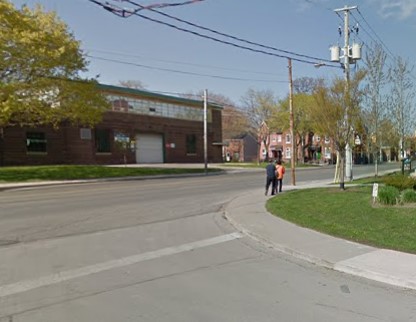
Dundas St E and Carroll after the installation of a truck apron:
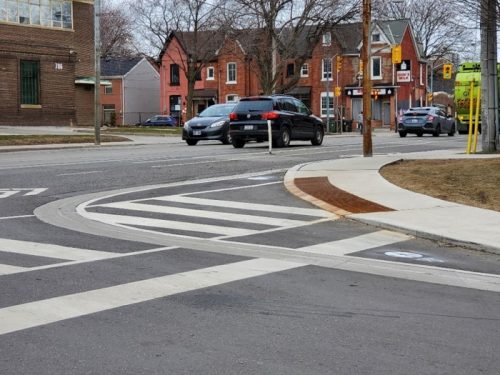
Toronto’s Curb Radii Guideline highlights the many benefits of an appropriately sized curb radii for all road users:
Intersection of Driftwood Ave and Yorkwood Gt before:
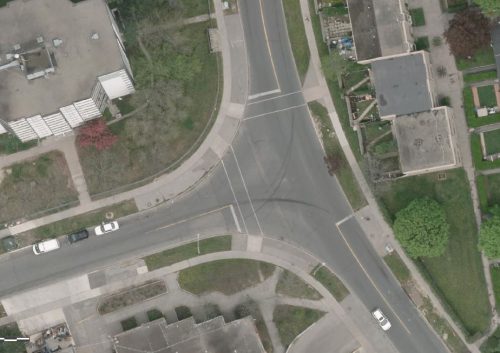
Intersection of Driftwood Ave and Yorkwood Gt after:
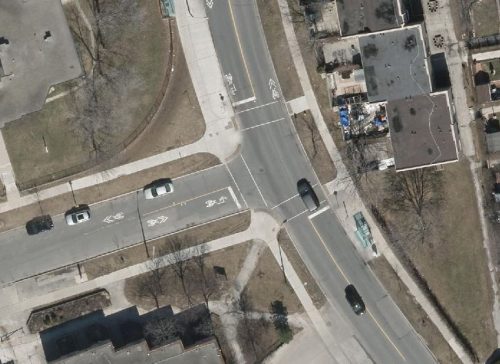
Speed humps are installed on local and collector roadways and are the most popular Traffic Calming measure in Toronto.
Speed humps are raised mounds of asphalt installed across the full width of a roadway. They are tapered towards the gutter to not impede storm water drainage.
Speeds humps are designed and placed at intervals along a roadway segment to encourage a consistent 30 km/h travel speed – motorists traveling at speeds greater than 30 km/h will experience discomfort when going over a speed hump.
Speed humps can be installed on local and collector roadways that receive winter maintenance.
Speed hump on Shaw St:
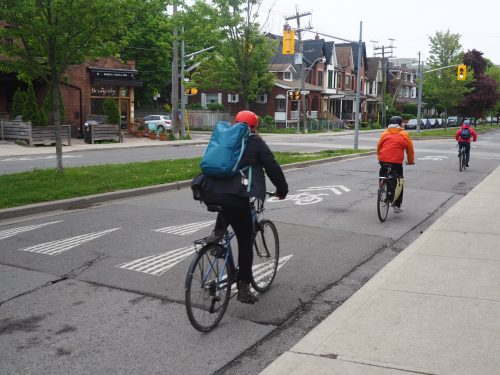
The installation of speed humps is dictated by the Council-approved 2023 Traffic Calming Policy.
Speed cushions are similar to speed humps, but they provide wheel cut-outs for larger vehicles such as buses and emergency vehicles to travel over them, minimizing the vertical deflection.
Due to their design, speed cushions have a slightly higher design speed than speed humps but enable the application of Traffic Calming measures where they may otherwise be infeasible, such as along a neighbourhood TTC route.
Speed cushions can be installed on local and collector roadways that receive winter maintenance.
Speed cushion on Tandridge Cres:
The installation of speed humps is dictated by the Council-approved 2023 Traffic Calming Policy.
Speed bumps are considerably shorter than speed humps and are found in very low-speed environments, such as laneways.
Speed bumps encourage drivers to cross at no more than 10-15 km/h.
Speed bumps can only be installed in laneways that do not receive snow plowing – only salting – as they are not designed to be traversed by plowing equipment.
Speed bump on Old Brewery Lane:
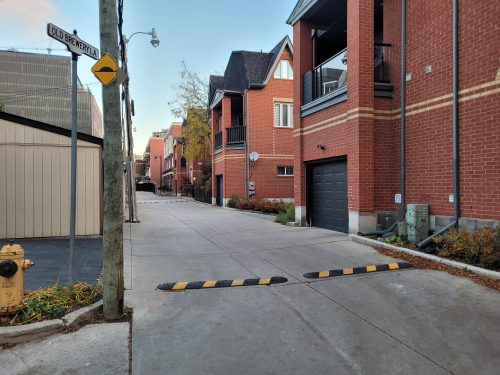
The installation of speed humps is dictated by the Council-approved 2023 Traffic Calming Policy.
The Raised Crosswalks Guideline provides context and design standards to improve the visibility between road users at intersections. They have been shown to decrease driving speeds, increase drivers’ compliance with posted signage and increase yielding to people crossing. Pedestrian accessibility is often improved. Raised crosswalks and intersections are typically installed during road reconstruction. They are proactively being programmed at stop-controlled intersections around schools.
Intersection of High Park Blvd and Indian Rd before:
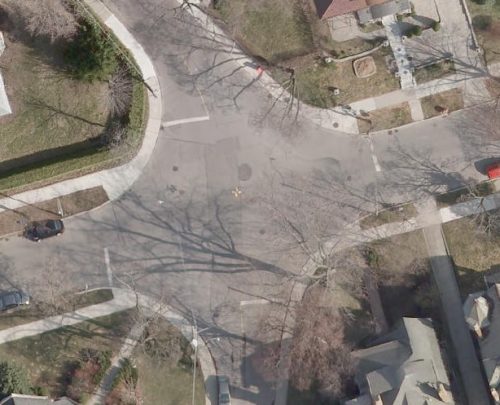
Intersection of High Park Blvd and Indian Rd after:
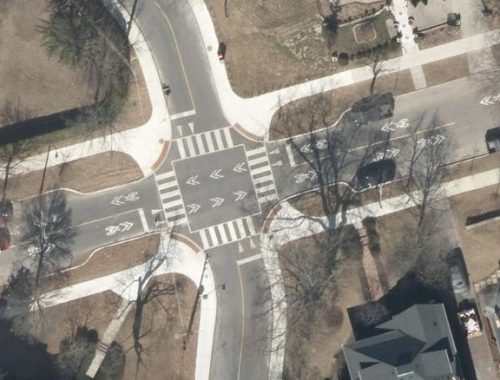
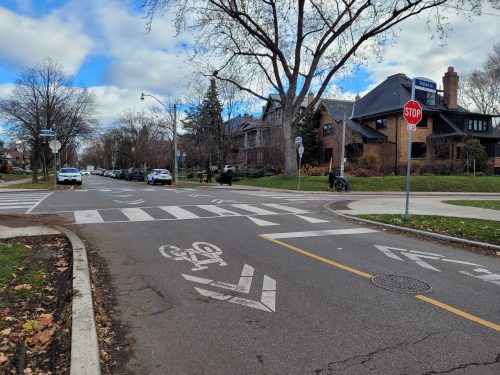
The City is working to make travel by bike safer and more inviting, helping to ease congestion on streets and transit, creating a cleaner environment, and promoting physical activity.
The City’s network of designated cycling routes are used by people to access neighbourhoods and destinations across Toronto. The cycling network includes many types of infrastructure, such as cycle tracks, bicycle lanes, shared roadway routes and multi-use pathways. The City uses different infrastructure and separation for its on-street cycling infrastructure depending on the nature and use of the road.
Flexible in-road traffic calming posts are signs that are installed on the centreline of roadways. They serve to reinforce maximum speed limits while also having a narrowing effect on the lane or roadway, contributing to lower driving speeds.
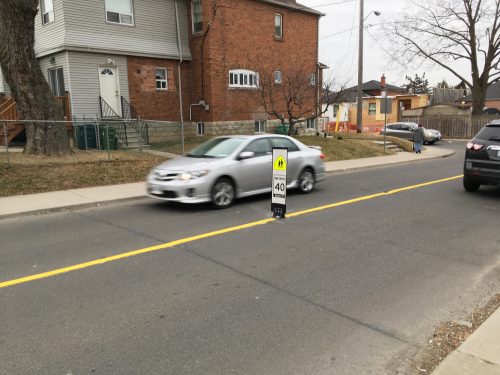
The Left-Turn Calming treatments aim to proactively reduce the risk of left-turn collisions at signalized intersections. The City is currently piloting these features at select locations, where speed bumps are added to extend medians and “harden” the centreline. This encourages drivers to approach the turn at a sharper angle, slower speed and with better visibility of people walking and cycling.
Designing a road to fit within its road classification and built environment is important to help regulate the speed of drivers. Opportunities for road narrowing can include a road reconstruction where the curbs can be adjusted and sidewalks added/improved, the addition of cycling infrastructure to better allocate existing road width, or the addition of on-street parking. Toronto has a Lane Width Guideline to help direct road engineering decisions with the aim of promoting a safer public right-of-way.
Glen Rd before narrowing:
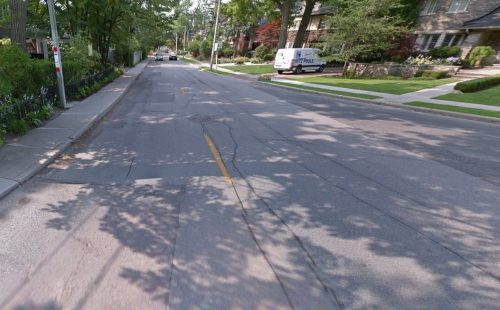
Glen Rd after narrowing:
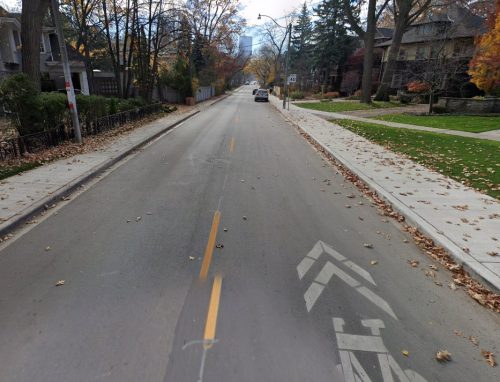
Provision of safe, comfortable and accessible sidewalks on all public streets is a fundamental objective of the Vision Zero 2.0 Road Safety Plan. Sidewalks support safety, accessibility, affordable transportation, physical activity, safe routes to school, aging in place and sustainable growth.
Through the Missing Sidewalk Installation Program, Transportation Services reviews opportunities to install sidewalks on all roadway classifications through bundling with other state-of-good-repair roadway or utility work, as well as stand-alone delivery.
Requests for new sidewalks can be sent to newsidewalks@toronto.ca
Highland Cres before new sidewalk:
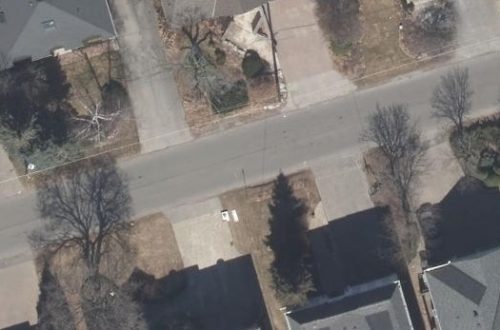
Highland Cres after new sidewalk:
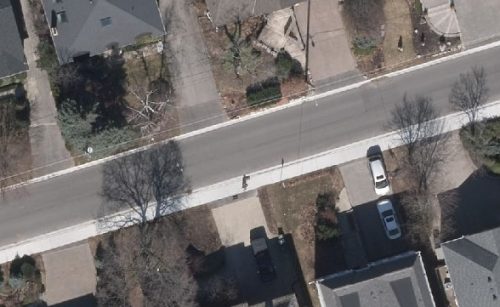
A Chicane is an alternating curb bulb-out that narrows the roadway in sections and helps reduce the travel speed of vehicles by creating an “S” shaped path. This can be done as part of a road reconstruction where the curbs can be adjusted or through alternating on-street parking from one-side to the other along a stretch of road.
Riverside Dr before:
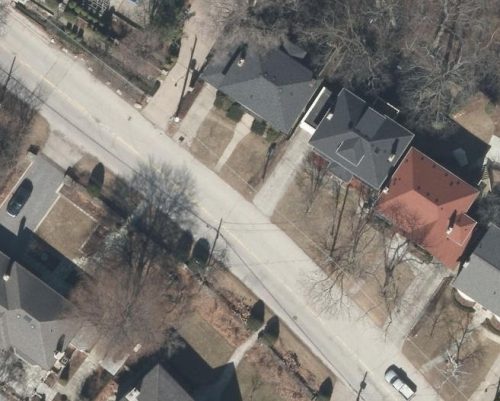
Riverside Dr after:
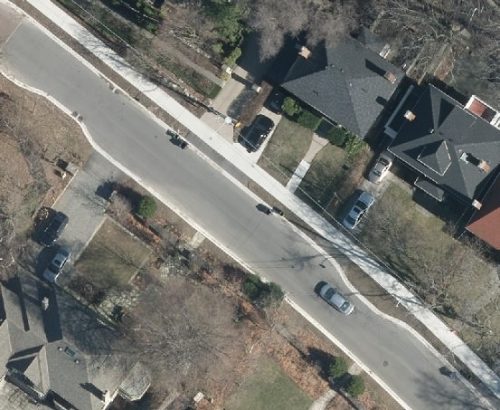
Curb extensions, also known as bump-outs are localized road narrowings for short sections where the pavement width is reduced by extending the curb into the roadway. Curb extensions may be constructed at intersection corners or mid-block. Curb extensions have impacts on vehicle speed, pedestrian crossing distance, visibility, pedestrian storage, street furniture, on-street parking and dedicated parking lanes. Toronto’s Curb Extensions Guideline provides additional context and design standards for implementation.
An intersection realignment involves modifying the layout of the roads and sidewalks to improve safety. Possible modifications can include:
The City of Toronto’s policy is to remove right turn channels if possible and not build new ones. The removal of right turn channels typically takes place during a road reconstruction.
Safety benefits include:
For locations where right turn channels can not be removed, they may be realigned to improve safety. Truck aprons and raised crossings may also be added.
Before the right turn channel removal at Millwood Rd and Laird Dr:
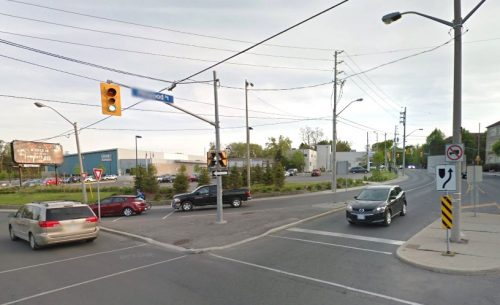
After the right turn channel removal at Millwood Rd and Laird Dr:
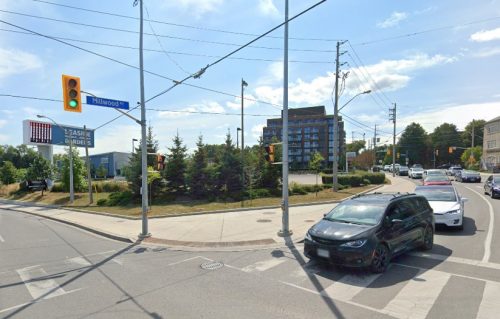
Quick Build safety improvement project involving a reduction in the corner radii at Eglinton Ave E and McCowan Rd using plastic bollards and paint:
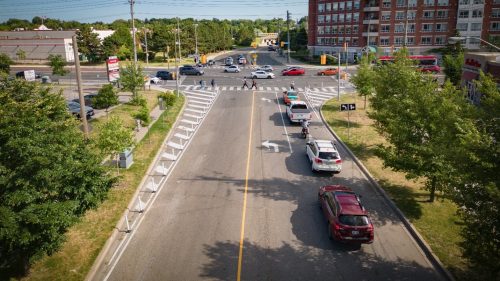
In support of the Council-approved Vision Zero Road Safety Plan, staff are using quick build materials such as paint, signs, and plastic bollards to deliver targeted safety improvements at high-priority locations. The Quick Build Safety improvement (QBSI) program will aid in addressing safety issues in advance of permanent improvements being constructed, whether as part of a larger state-of-good-repair road resurfacing or reconstruction project or as a standalone safety improvement project. The anticipated timeframe from quick-build improvements to permanent construction varies, primarily based on project prioritization but also subject to factors including coordination with state-of-good-repair work, work zone coordination with adjacent projects, and funding.
Typical interim road safety improvements include:
The majority of quick-build safety improvement locations, typically intersections, are prioritized based on a history of collisions that result in serious injuries or fatalities. A smaller selection of projects respond to safety issues identified and requested by community groups, Councillors and internal City groups.
The designs are completed per the City’s Road Engineering Design Guidelines, based on the proposed recommendations to improve safety for all roadway users and to bring the intersection(s) up to current design standards. The use of quick-build materials allows the City the opportunity to realize safety improvements in the near-term, as well as the ability to test design assumptions before a project is made permanent.